Low-power Signal Processing Trends
A decade ago, low-power digital signal processing applications were rare, largely due to the lack of energy-efficient processors. Today, advances in chip fabrication techniques and processor architectures have dramatically improved energy efficiency for a broad range of processors. In addition, energy efficiency has become a top consideration for designers of some classes of processors—in some cases eclipsing factors such as speed. These advances are opening up vast opportunities for new low-power signal-processing products.
In this article, we present an overview of important market and technology trends behind the growth of low-power signal processing applications. We highlight developments in consumer electronics, medical devices, and military applications, and we take a close look at developments in the cell phone market.
Cell Phones Pile It On
The cell phone is the best-known low-power digital signal processing application. As shown in Table 1, about 500 million cell phones shipped last year. To put this figure in perspective, consider that worldwide shipments of DVD players—which are considered a highly successful product—reached only about 60 million units last year (source: iSuppli, September 2003). The extraordinarily large volumes associated with the cell phone market have made this market a dominant driver of developments in energy-efficient signal processing technology.
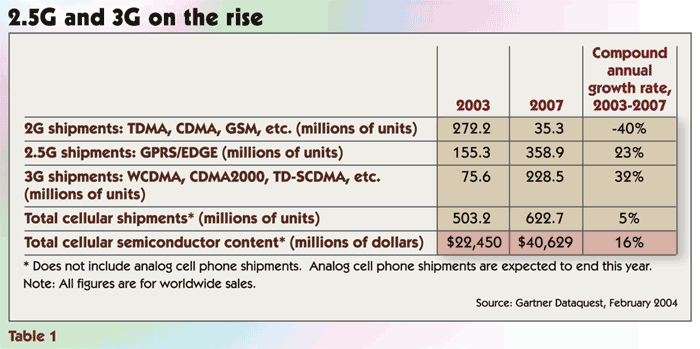
Standby Power Makes Trouble
Like many other low-power products, cell phones spend most of the time in standby mode. In standby mode, a phone does little more than monitor for an incoming call. Hence, the power consumed during standby mode is much lower than the power consumed during phone calls or other activities. However, cell phones spend so much time in standby mode that the energy consumed during standby mode often determines the overall battery life of the phone. (Battery life depends primarily on energy consumption, as opposed to power consumption. However, it is sometimes important to minimize power consumption as well as energy consumption. For more on this topic, see "Power, Energy, and Battery Life.")
A cell phone's energy consumption in standby mode is typically dominated by the energy consumption of the baseband processor. (Baseband processors handle voice and communications processing in cell phones.) In practical terms, this means that the baseband processor's standby power plays a large role in determining the battery life of a phone. Unfortunately, standby power tends to increase as CMOS fabrication geometries shrink. This has made reducing baseband processor standby power a key challenge for cell phones. (See "Designing Low-Power Signal Processing Systems" for a discussion of standby power and ways designers can minimize it.)
Communications Loads Increase
Processor power consumption is a smaller percentage of total power consumption when the phone is in active use, but several factors are increasing the computational load—and hence creating a need for greater processor energy efficiency—when the phone is in use. First, the computational loads for wireless communications are increasing. For example, the computational loads for a "3G" transceiver are several times higher than those for a "2G" transceiver. In addition, phones are adding support for non-cellular communications such as wireless local area networks, which allow phones to communicate with computer networks, and Bluetooth, which allows phones to communicate wirelessly with headsets and other peripheral devices.
Cell phones are also adding GPS, television, and FM radio receivers. As shown in Table 2, cell phones are already the largest market for GPS chips. These chips help public safety personnel locate the caller in case of an emergency. Integrated GPS also enables services such as recommendation of nearby restaurants.
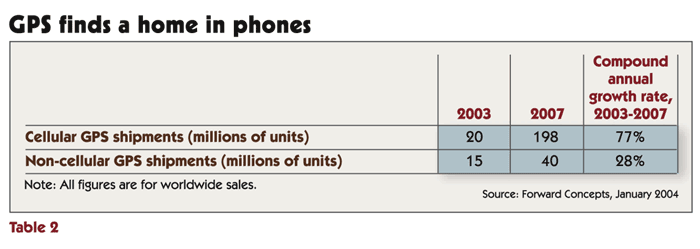
The integration of TV receivers into cell phones will also enable new services. Cell phones that implement the recently approved Digital Video Broadcasting-Handhelds (DVB-H) specification will be able to receive television broadcasts delivered either via a digital terrestrial TV network (DVB-T) or a cellular network. DVB-H is also expected to enable interactive features such as video-based shopping.
User Applications Go Live
Television reception is only one example of the crop of multimedia applications appearing on cell phones. These multimedia applications are dramatically increasing the computational loads seen in cell phones.
Mainstream phones already have limited multimedia capabilities. For example, even fairly low-end phones are capable of playing downloaded ringtones and displaying JPEG image files. Many high-end phones are capable of playing audio and video in formats such as MP3 and MPEG-4.
Cell phones are also gaining the ability to record audio, still images, and video. According to the CTIA, 75 million camera phones were sold worldwide last year; this is roughly 50% higher than the number of stand-alone digital cameras sold worldwide last year. It is entirely possible that camera phones will largely replace low-end digital and film cameras in the next few years.
Indeed, cell phones are rapidly converging with a host of other devices. The most prominent example of the trend is the "smart phone," which combines a cell phone and a PDA. And just as cell phones are now incorporating PDA features, many handheld computers—which include PDAs and industrial handhelds—are adding wireless communications capabilities. As shown in Table 3, sales of smart phones are expected to grow rapidly, while sales of handheld computers are expected to remain flat. Hence, high-end cell phones may subsume both stand-alone PDAs and low-end digital cameras. As if that were not enough, high-end phones are also expected to add powerful 3D gaming capabilities in the next few years, enabling some phones to replace portable gaming platforms.
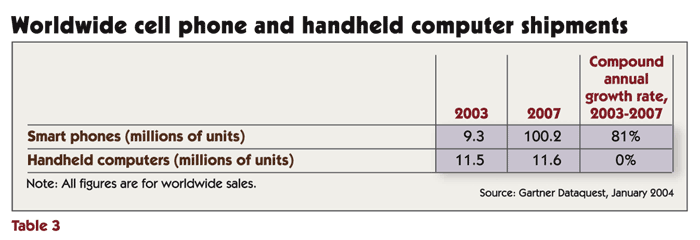
High-end cell phones must handle all of these processing demands—the increased communications loads and the new audio/video and gaming tasks—while equaling or even exceeding the battery life of traditional cell phones. And this must happen even as battery sizes are being reduced to enable smaller form factors and to make room for new features such as removable memory cards. This is a monumental engineering challenge.
More Than Phones
A variety of other wireless communications technologies also require energy-efficient signal processing technology. Figure 1 shows some of these wireless communications schemes and the applications that use them.
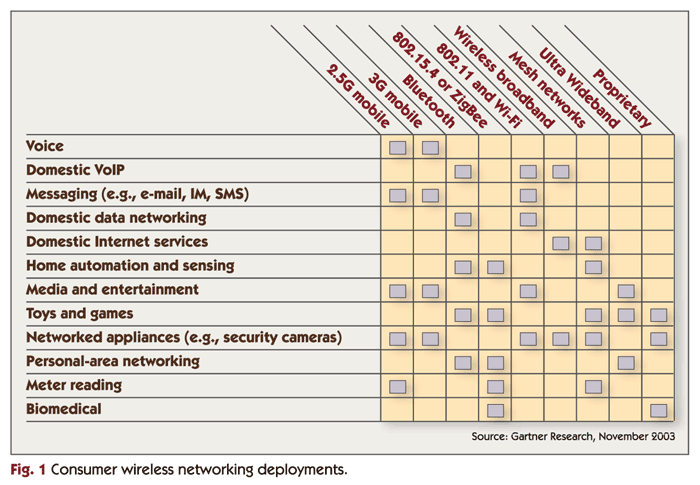
Consumer Electronics Go Digital
Portable consumer electronics include many applications of energy-efficient signal processing technology. For example, digital still cameras increasingly rely on DSP processors. DSPs are an attractive solution for the digital still camera market because their programmability enables camera designers to quickly develop a broad range of cameras with a variety of feature sets and price points.
As in the cell phone market, the computational loads of digital still cameras are rapidly increasing. As a result, advances in processor energy efficiency will be required to maintain battery life. The processing load for a digital still camera is proportional to the camera's resolution and frame rate. High-end cameras now offer resolutions of over six megapixels and frame rates exceeding three frames per second. Even for cameras with more modest resolutions and frame rates, processing loads are increasing as vendors add features such as color enhancement.
Digital still camera processing loads are also increasing as vendors add more extensive video-recording capabilities to their still cameras. Digital still cameras have long been able to record video, but the video quality was often poor and cameras were usually able to record only a few seconds at a time. In contrast, many forthcoming cameras will be able to record high-quality video for many minutes at a time.
Indeed, the line between digital still cameras and digital video cameras is likely to blur in coming years. High-end digital still cameras may subsume the low-end digital video camera market in the same way that cell phones may subsume low-end digital still cameras. Table 4 shows market forecasts for both types of cameras.
Portable digital music players (also known as "MP3 players") also require energy-efficient signal processing technology. Existing players offer relatively long battery life—over 15 hours in some cases. However, this battery life comes nowhere near matching the storage capacity of hard disk drive-based designs, which can store hundreds of hours of music. In addition, a few players now offer video playback as well as audio playback. Video playback requires significantly more power than audio playback, so energy efficiency is even more important in these products. Table 4 shows market forecasts for portable digital music players.
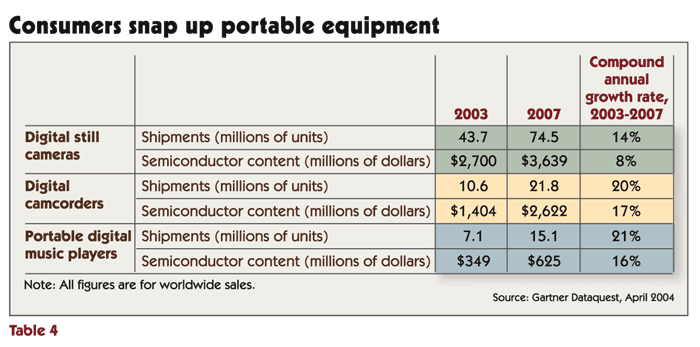
One of the most interesting applications of energy-efficient signal processing technology is Microsoft's "Smart Personal Objects Technology (SPOT)" smart watch initiative. (See David Carey's "Under the Hood" column for a teardown of a Fossil SPOT watch.) SPOT watches, which began shipping early this year, receive personalized information such as messages, stock prices, and weather from a digital signal in the FM broadcast subcarrier. The smart watch is a good example of a product that is made possible by modern energy-efficient signal processing technology. It has been possible to build such a device for many years, but without highly efficient signal processing, the size of the battery would make the watch unfashionably bulky.
Medicine Hears the Need
While wireless communications and consumer electronics are larger markets, medical devices are in many ways at the forefront of low-power signal processing applications. Many medical applications rely on tiny batteries that must last for extended periods of time.
Hearing aids are perhaps the best-known example of a low-power medical signal processing application. Table 5 shows a market forecast for these devices. While analog hearing aids have been available for decades, hearing aids that use digital signal processing technology offer a number of compelling advantages. For example, a digital hearing aid can offer a directional mode that amplifies sounds coming from directly in front of the wearer but suppresses sounds from all other directions. This feature is invaluable if the wearer is trying to hold a conversation in a noisy environment such as a restaurant.
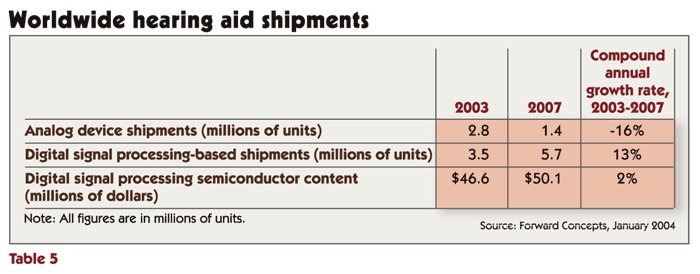
Energy-efficient signal processing technology is also invaluable for implanted devices such cardiac rhythm management devices (which include pacemakers and defibrillators). These devices require extremely high energy efficiency because the only way to replace a battery is through surgery. As a result, designers of these implanted devices seek to lower the device energy consumption to match the battery's self-discharge rate. (The self-discharge rate is the rate at which the battery loses energy even when it is not connected to a load.) Devices that meet this goal can last for ten or even fifteen years.
Constraining energy consumption to the battery's self-discharge rate is a major engineering challenge. Because implanted devices must respond to changes in the patient, they must constantly monitor and analyze incoming signals. In addition, implanted devices generally provide wireless communications to allow the physician to download data from the device and change the device's settings.
Military Apps March Forward
Energy-efficient signal processing is also important in a variety of military and government applications. The U.S. Department of Defense (DoD) software-defined radio (SDR) program is one of the more prominent military applications of energy-efficient signal processing. U.S. military operations often require communications among different branches of the armed forces, but branches often use incompatible radio systems. To address this problem, the DoD initiated the Joint Tactical Radio System (JTRS) program, which seeks to migrate all U.S. armed forces to SDR systems. The goal is to create radio systems that can communicate not only with each other, but also with legacy systems and with the systems of U.S. allies.
The initial JTRS work focuses on military vehicles and aircraft, which do not require particularly energy-efficient radios. However, the DoD has already begun work on hand-held software-defined radios. Eventually, the program may encompass over 750,000 radios, including tens of thousands of portable units.
Two-way radios used for public safety services such as fire and police departments are also receiving increased attention due to compatibility concerns. In many cities, the radio systems used by various public safety services are incompatible. In large-scale emergencies, these incompatibilities are potentially disastrous. As a result, the SDR technologies being developed for the DoD may also be attractive for civilian emergency services applications.
Powering Down...
Advances in energy-efficient digital signal processing technology have revolutionized low-power applications. Efficient digital technology is quickly replacing analog technology in many established applications. In addition, efficient digital signal processing technology is enabling entirely new applications. And the best may be yet to come: processor vendors are finally making energy efficiency a top consideration, opening the possibility of huge leaps in energy-efficient signal processing technology.
But despite these advances, major challenges face developers of low-power signal processing applications. In many existing low-power applications, computational loads are increasing rapidly even as battery sizes are shrinking. These conflicting trends ensure that system designers will continue to push for ever more efficient digital signal processing technology for years to come.


Add new comment